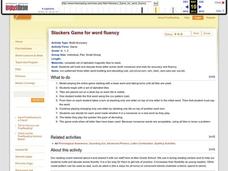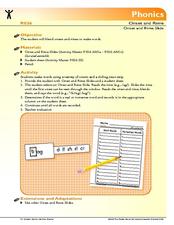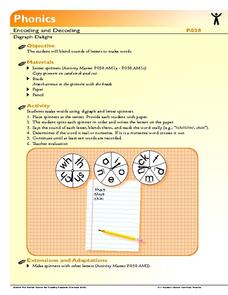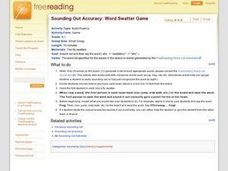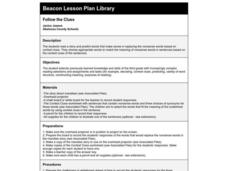Curated OER
Stackers Game for Word Fluency
Explore words by building and decoding three-letter words. Real or nonsense words can be formed with the alphabet tiles. Practice fluency and blending sounds with CVC patterns.
Curated OER
Latin Roots fin, sed, fer: Synonyms and Antonyms
Secondary etymologists assign synonyms and antonyms to six English words based on the Latin roots fin, sed, and fer. MyVocabulary.com ranks this as beginner-level, but the work is challenging. A 24-item word bank provides two acceptable...
Florida Center for Reading Research
Phonics: Encoding and Decoding, Three-In-One
Scholars use the provided pack of alphabet cards to construct basic CVC words, then write down each word they make in one of two columns. Column one is for real words and column two is for nonsense words.
Curated OER
Recognize Nonsense Words
In this nonsense worksheet, learners read six sentences and replace the blue nonsense word with a better word from two choices. Students write the more logical word on the line.
Curated OER
Absurdities: Nonsense Words Don't Fit
In this absurdities worksheet, students read 6 illustrated sentences and analyze the nonsense word in blue. Students replace the word with the best choice from 2 choices.
Heidi Songs
Ladybug Color Nonsense
Let these ladybugs teach your youngsters a thing or two about spelling CVC words. Kids color the real words black and the fake words red to reveal what these ladybugs really look like.
Florida Center for Reading Research
Onset and Rime Slide
Discover onset and rime blends using this interactive activity which will appeal to your kinesthetic learners. Using the sliding templates provided, budding readers try different onsets with each rime. They practice reading skills by...
Florida Center for Reading Research
Phonics: Onset and Rime, Word Swat
With a fly swatter in hand, learners swat the rime-flys with their onset swatter to make, read, and write words by blending the onset with the rime-fly. Scholars blend words, make and write words, and also work to determine if the words...
Curated OER
"Jabberwocky": Inferring
Pupils, over an extended time, read and explain the nonsense words of Lewis Carroll's poem, "Jabberwocky". They infer the meaning of the poem using visualizing as well as decoding skills. While written for first graders, this is easily...
Scholastic
Frindle Lesson Plan
"Who says a pen has to be called a pen? Why not call it a frindle?" Inspired by this quote from the award-winning novel written by Andrew Celements, this lesson allows children to invent their own terms for common classroom objects,...
Curated OER
Sounding out accuracy, Build a Word
Students demonstrate how to build words. In this word study activity, students play a game where they must choose two index cards from each bucket and put them together to build a word.
Curated OER
Write Your Own Poem: Rhyming Word Pattern -end, -ind, -and
For this rhyming verse worksheet, students read 20 words in a chart and color them according to the directions, using a different color for each ending rhyme pattern. Students then answer 10 questions in which they write simple nonsense...
K12 Reader
Jabberwocky
Readers demonstrate their ability to use word endings and word relationships to identify the parts of speech of the nonsense words in Lewis Carroll's "Jabberwocky."
Curated OER
Nonsense Dictionary
Third graders explore various media. They identify the characteristics of various sources and use that material effectively. Students identify the characteristics of Dr. Seuss' work and the characteristics of a dictionary. They create a...
Florida Center for Reading Research
Phonics: Encoding and Decoding, Digraph Delight
There are three spinners to use in this phonic activity. Spinner one contains digraphs, spinner two contains vowels, and spinner three contains consonants. Learners spin each spinner, write down the letters they get, blend them to make a...
Florida Center for Reading Research
Phonics: Onset and Rime, Word-Roll-A-Rama
Learners roll two die; die one contains various onsets, and die two contains different rimes. They write down the onset and rime pair they get, then blend and read their word.
Curated OER
Stackers Game for word fluency
Young scholars create three letter words and decode for fluency and accuracy. In this fluency lesson, students use alphabet tiles to build words with the CVC pattern and read the word aloud. Young scholars alternate turns by stacking...
Curated OER
Sounding Out, Alien Word Game
Students invent words using a set of letters. In this Alien word lesson, students determine if the letters made a real word. Students record problem words in an activity log.
Curated OER
Analyzing Unknown Words
Learners analyze affixes and how they affect word meaning. In this language arts lesson, students use charts to construct and deconstruct words to find meaning.
Curated OER
Sounding Out Accuracy: Word Swatter Game
Students explore word fluency by participating in a language arts game. In this vocabulary identification activity, students collaborate in two small teams, each armed with a fly swatter, in order to swat vocabulary words spoken by their...
Curated OER
Most Common Words List
In this word recognition worksheet, students recognize high frequency words. Students read a story and circle all the most common words each time they appear. They also complete fourteen fill-in the blank questions by placing the high...
Curated OER
The Creaky Door Says "ehhhh"
Study the long vowel sound /e/, as in a creaky door noise. Children repeat the sound and learn a chant. They use letters in letterboxes to make words with the /e/ sound before reading a book and writing a message about their favorite...
Curated OER
Nonsense Knows
For this poetry lesson, young readers discuss that poems can sometimes have silly words and made up people, places, and things. Students read and listen to silly poems then write a response poem to their favorite.
Curated OER
Follow the Clues
Students read a story and predict words that make sense in replacing the nonsense words based on context clues. Students choose appropriate words that will match the meanings of the nonsense words.
Other popular searches
- Nonsense Words List
- Context Clues Nonsense Words
- Phonics Nonsense Words
- Nonsense Words Kindergarten
- Nonsense Word Fluency
- Nonsense Words Cards
- Cvc Nonsense Words
- Nonsense Words Worksheets
- Cbc Nonsense Words
- Dr Seuss Nonsense Words
- Nonsense Words Lessons
- Nonsense Word Cards


